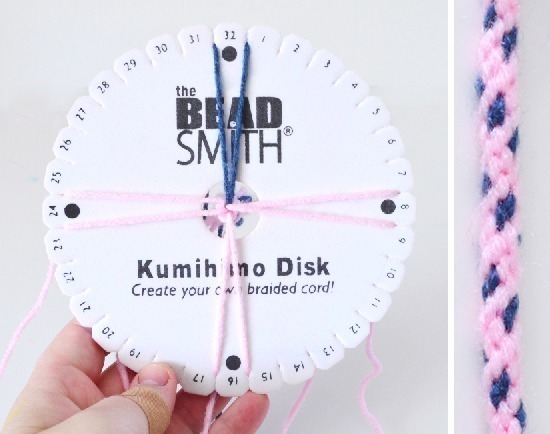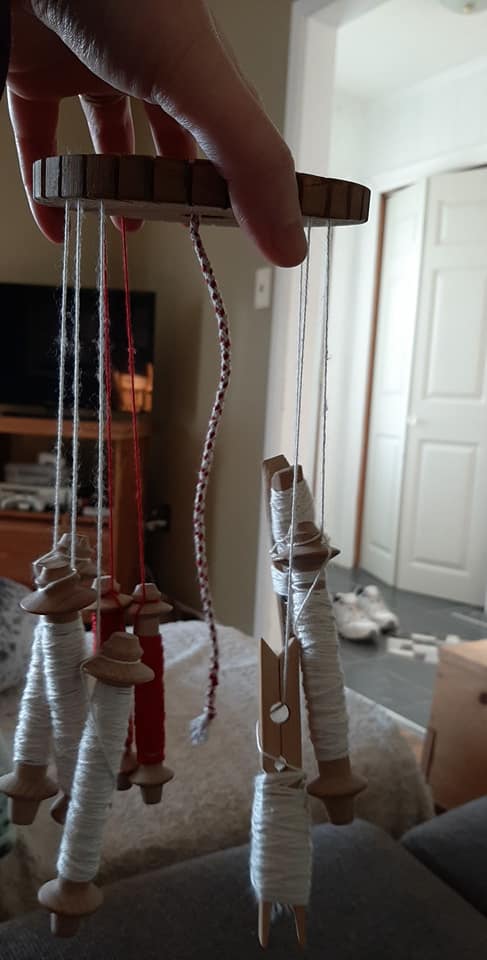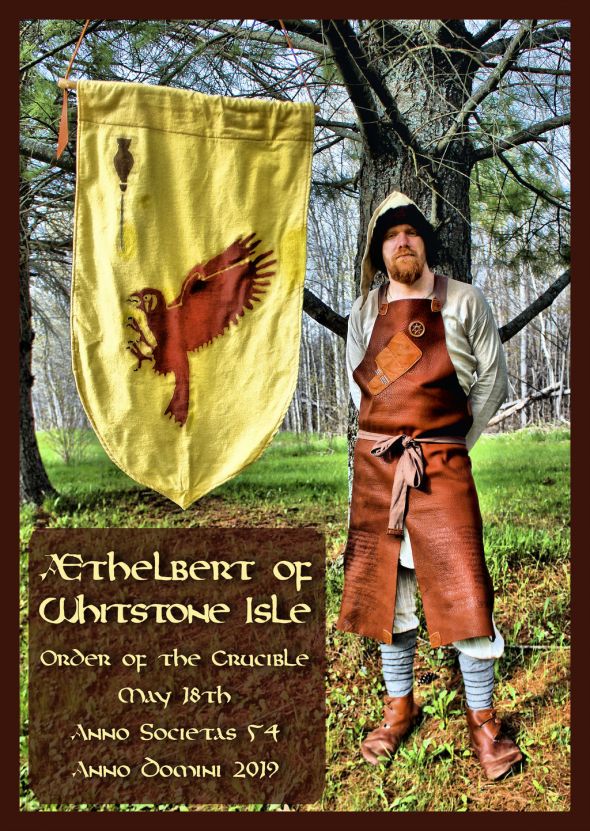Lets Get A Bit Medieval When Dealing With COVID-19
Leave a commentJul 25, 2020 by Rua Lupa

Mask Pattern by Daisy Multifacetica
For proper fitting I used the Large Adult pattern by Daisy Multifacetica.
The silk cord was Kumihimo. The silk itself was from an a collection I had ordered form Beatrix for a previous project that was silk which needed silk thread for long lasting durability. While Beatrix is actually a jewelry based business, their silk threads were excellent quality at excellent prices.

Silk and Bobbins from Beatrix. Photo by Rua Lupa. July 12020HE.
Since I did not have a Kumihimo wheel to weave with, I made the weaving wheel from a circle piece of a distaff from an old FOOL (Fruits Of Our Labour) class craft project. I had printed a 32 divided Pie chart and used that to mark the notches. Fastening the wooden wheel in a vice, I then used a Leatherman saw blade to cut each notch. The Pattern I referenced was an 8 Strand Pattern. The way this is woven is shown here.

an 8 Strand Kumihimo Pattern. Source: https://www.dreamalittlebigger.com/post/8-strand-kumihimo-patterns-by-color-placement.html

Weaving Kumihimo. By Rua Lupa. April 2020.

Red and White Silk 8 Strand Kumihimo. April 2020. By Rua Lupa.
I had measured my length by stretching the thread between my outstretched arms, 4 lengths. This had made enough for two to three masks depending on how much length you desired for tying it to the back of your head. Once I finished weaving the cord, I tied the ends off with red silk using the method I learned from his Excellency Duncan MacLeod at his Rope Making class at Trillium War, Anno Societatis 53 / 12018HE.
As mentioned before, the materials for the mask were what I was able to find around the home. What resulted was the inner most layer was made of cotton, the center layer is silk, and the outer layer is canvas – with the silhouette of their sparrowhawk cutout and embroidered onto the center silk layer, functioning as a breathing hole. Once worn we found that the Kumihimo cord has great functional qualities – it had some stretch to it so when fastened tightly it would not slip nor would it be constricting. The mask being designed to have a cord tied behind the head avoided the notorious problem of ear pinching altogether.

Æthelbert of Whitstone Isle, with undyed Mask, Sewn and Embroidered with Heraldry. Mask and Photography By Rua Lupa. May 2020.
Since Æthelbert’s Heraldry Device was on a Yellow Field (Background) it was then dyed with onion skins that were saved up for months, Potassium Aluminium Sulfate, and Cream of Tartar.

Referenced Book. Wild Color, by Jenny Dean

Referenced Book, Dying with Onion Skins on page 72. Wild Color, by Jenny Dean.
I had a 4 Litre jar stuffed with saved onion skins that was then left to soak in water for 24 hours. In a separate bowl I soaked the mask in water at the same time – this opens the fibers to take the dye better. I then separated the skins from the dye water. In a 3rd container, a mason jar, I dissolved the Alum and Creme of Tartar in boiling water from the kettle, added the dye water, and then the mask. It was shortly after I realized a mistake – I did not do a thorough hot water wash to ensure the red in the silk did not spread and dye the fiber! So I quickly removed the mask and saw some pink already present, and diligently hot washed the mask until I no longer saw red leaching from it. After that I had it soak in the dye Jar over night, and it came out a lovely color! Unfortunately the vigorous washing I did previously revealed my sewing on of the edging had not overlapped far enough and frayed on either side of the nose bridge. Luckily, as seen in the Beatrix image, I had a thread color that would match perfectly for repairing.

Æthelbert of Whitstone Isle, with Onion Dyed Mask, Sewn and Embroidered with Heraldry. Mask and Photography By Rua Lupa. June 12020HE.
One thing I wish I did was dye in cold water for longer instead, that way the Silk would still have it’s luster. But it was not a major loss, considering I still ended up with a fantastic looking mask that was easy to use.
While I was weaving the cord, embroidering, and mending the frays, I was kept entertained by some youtube channels that really kept me engaged but did not necessarily require me looking at the screen the entire time. If you are interested in doing this yourself, I recommend checking out Extra Credits (History and Mythology), SciShow, Shadversity, Ben G Thomas, Atlas Pro, Absolute History, Cogito, Zefrank1 for their TrueFacts series, The History Guy: History Deserves To Be Rememebered, and TierZoo.
Not long after I finished this project I learned that the SCA regional group leaders – Their Majesties of the Kingdom of Ealdormere – were calling a challenge for Heraldic Masks that was announced this July. So I was pleased that not only were they encouraging the same idea I had, I was already finished to enter! I hope this article inspires others, in the SCA I am part of and beyond, to go Medieval with their Masks 😉
Take Care Everyone! I look forward to seeing you after the Plague!
Category: Crafting, Political Barking, Rua's Rambles, Seasons & Stardust, The Cairn | Tags: culture, DIY, Ehoah, heraldry, history, Living History, Medieval, Medieval Heraldry, Religious Naturalism, SCA, science, World

